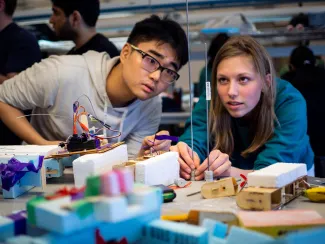Steve Zimmerman
- Degree:
- Bachelor of Applied Science
- Grad year: 2020
- Program:
- Campus: Vancouver
Job: Modelling and Simulation Engineer, Blue Origin
What got you interested in engineering?
I always liked building things, and I also really enjoyed math. For awhile I thought of becoming an automotive mechanic, but I wanted a job that included more math. Engineering was a way for me to pursue both of these interests.
Any highlights from your time as an undergraduate at UBC?
Many Mechanical Engineering courses – starting with MECH 2 – require you to spend a lot of time in the machine shop.
It’s very valuable to go through the hard and challenging process of actually fabricating things yourself, figuring out why initial concepts might not have worked and then redesigning as needed.
My involvement with UBC AeroDesign is another example of the satisfaction that comes from building things. The team designs and builds remotely controlled airplanes and drones.
I initially joined as a team member and then progressed to being captain when we designed and build a 50-pound airplane that we entered into a heavy-lift competition in the US.
To be honest, being part of this team was an insane amount of work. But it was a fantastic opportunity to gain very solid project experience. That generates certain advantages and can help you stand out when applying for jobs, but more importantly, it’s really just a lot of fun.
As team captain, I also learned a lot about the non-technical aspects of engineering and what it takes to manage people and build a great team. Those skills have also been very useful in my career.
Where are you working now?
After I finished my master’s degree I got a job at Blue Origin in Seattle where I am a controls engineer. I really enjoy the technical problem-solving nature of my job, which enables me to integrate core mechanical engineering principles with elements of software engineering design.




